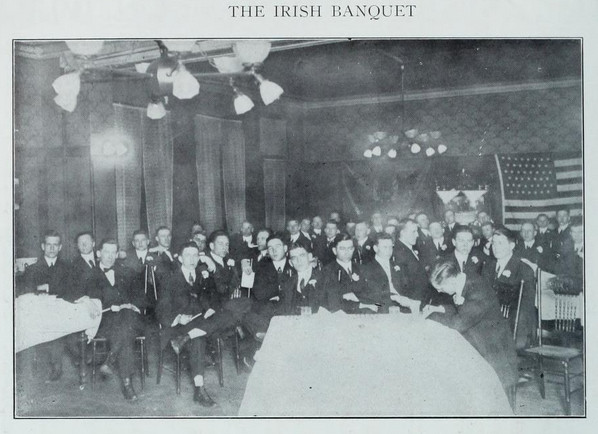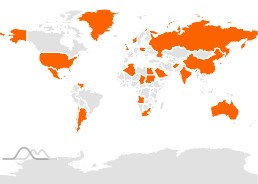Since at least 1895, Irish students have been attending the University of Illinois. Early Irish Illini have included athletes, lawyers, orators, professors, stock raisers, and writers. Read on to learn about early Irish Illini!
Early Culture Organizations
Before the first cultural organizations were formed on campus, Irish students had been attending the University of Illinois. In fact, the 1895 Illio reported that as much as 3.5% of the class of 1896 had Irish-born parents. [1] However, it was not until the early 1900s when the first Irish cultural student organizations were formed.
Ancient Order of Hibernians
Before there were student organizations, there were off-campus Irish culture organizations like the Ancient Order of Hibernians (AOH). [2] However, it is possible that a student chapter of the AOH existed during the early 1900s, as seen in the 1901 Illio club profile (below). As evidenced in membership surnames, it is possible that many members were descendants of Irish immigrants or other students interested in Irish cultures.
Sons of Erin St. Patrick’s Day Dinners
At the same time as the Hibernians, Daily Illini reports began referring to Irish students as “Sons of Erin” [3]. Regardless of their name or their family’s immigration history, early Irish Illini organized annual St. Patrick’s Day dinners for fifteen years on campus. [4] The Sons of Erin’s first dinner was in 1903 and the last dinner was in 1917. Early advertisements for dinner reservations invited male Catholic students, while later dinners were open to all students interested in Irish cultures. [5] Over time, the dinners grew in size to become “St. Patrick’s Day Banquets” advertised in the Illio for 1911, 1912, and 1913. In fact, most dinners featured a student toastmaster too.
Every annual dinner featured a student toastmaster and each dinner was hosted at a different venue in Urbana-Champaign Venues ranged from Beardsley Hotel (1907-09), to College Hall (1910), to Leming’s Cafe (1911), to Columbian Hotel (1912), to College Hall (1913), and to Hotel Inman (1915). Over time, the event grew to include orations, live music, as well as tobacco and food imported from Ireland too. [6]
Irish Studies
Coinciding with the increased Irish student organizations and social events on campus, new faculty member Dr. Gertrude Schoepperle coordinated an Irish Studies program. While her final results were unsuccessful, Dr. Schoepperle was able to bring two Irish scholars to campus and put the University on the historic map of Irish studies scholarship in North America.
Gertrude Schoepperle
It was Spring 1912 when Dr. Schoepperle (Associate Professor of English 1911-1912, 1913-1919) first offered a new English Department graduate course in Celtic and for one decade she developed Irish Studies at the University. [7] As she later recalled, the graduate course was difficult to fill with students because the field of Irish Studies needed a great amount of scholarly work done to edit extant works for readers. To support Irish studies, Dr. Schoepperle visited Irish communities across Illinois in search of funding for visiting scholar fellowships and for student scholarships. During her time on campus, Dr. Schoepperle developed an undergraduate Irish literature course (taught in translation) and inspired the Ancient Order of Hibernians of Bloomington, Illinois to donate to an annual Irish literature and history contest for University undergraduates.
Kuno Meyer
From 1915 to 1917, Dr. Kuno Meyer was Visiting Professor in Celtic Language and Literature. [8] Dr. Meyer was a distinguished Irish lexicographer who founded multiple Celtic Studies journals, was Director of the School of Irish Learning in Dublin, and a former professor at the University of London and the University of Liverpool. While in Illinois, Dr. Meyer taught multiple courses on Celtic studies, until he returned to his native Germany during his final years.
During his time as an instructor, some of Dr. Meyer’s students quickly realized personal scholarly success. In 1915, two undergraduate students, Lucillle Needham and Olive Hormel, published revised term papers (under Dr. Schoepperle’s guidance) from Dr. Kuno Meyer’s course, in the Sewanee Review. As a scholar during his twilight years, Dr. Meyer completed multiple works at the University too, including the Miscellanea Hibernica.
Andrew O’Kelleher (Aindrias Ó Céileachair)
With the support and active involvement of University President Edmund Janes James, Dr. Schoepperle was able to arrange an Irish Fellowship Club of Chicago fellowship to support Dr. Andrew O’Kelleher (as a Fellow in Gaelic at the University) to complete the translation of Manus O’Donnell’s Betha Colaim Chille: Life of Columcille. [9] While researching on campus, Mr. O’Kelleher voluntarily taught a non-credit course in Gaelic too. [10]
After the end of Dr. O’Kelleher’s fellowship, Dr. Meyer had returned to Germany while Dr. Schoepperle married fellow Illinois English professor (and Arthurian scholar) Dr. Roger Sherman Loomis and left the University. Concurrent with the end of the early endowed Celtic Studies program movement, it was January 21, 1919 when Dáil Éireann, the revolutionary parliament of the Irish Republic, adopted the Irish Declaration of Independence.
From September 13, 2016 through April 2, 2017, the University of Illinois Spurlock Museum has hosted the temporary exhibit “Medieval Irish Masterpieces in Modern Reproduction” which includes reproductions of Irish metalwork and original manuscripts acquired through Dr. Schoepperle’s efforts for Irish Studies at Illinois.
Are you an Irish Illini? Do you know someone who is? We’d like to hear from you! Please send us a message or leave a comment below. We want to include you and your story, as we celebrate the first 150 years of the University of Illinois.
Happy First 150 everyone!
References
[1] Illio, page 167, 1895. Records Series 41/8/805. Prior to the Irish Declaration of Independence on January 21, 1919, there had been over one hundred University of Illinois faculty, graduates, or staff who were either born in Ireland or who had at least one Irish-born parent. Please see: The Alumni Record of the University of Illinois at Urbana, 1918.
[2] Hibernia is the classical Latin word for “Ireland”. For more newspaper articles about local AOH events, please see the historic Champaign Daily News (1885-1919) generously available online through the Illinois Digital Newspaper Collections.
[3] The name “Erin” is a Hiberno-English word for Ireland from the Irish Gaelic language.
[4] The first pre-dinner gathering was organized among Catholic students. Please see: “Items of Interest”, The Illini, March 12, 1903, page 3.
[5] “Items of Interest”, The Illini, March 19, 1903, page 3.
[6] Lists of orators and imported products can be found in The Illini reports to announce the banquet.
[7] A complete account of the University of Illinois Irish Studies program can be read in Schoepperle, Gertrude, “Irish Studies at the University of Illinois“, (Dublin Quarterly) Studies, Volume VII, Number 25, 100-11.
[8] More information on Dr. Kuno Meyer can be found in the correspondence of Edmund Janes James, Record Series 2/3/5.
[9] More information about the publication can be found in the Irish Foundation Series, Record Series 7/1/814.
[10] “Irish Students Offered a Chance to Learn Celtic”, The Illini, September 28, 1917, page 6.








